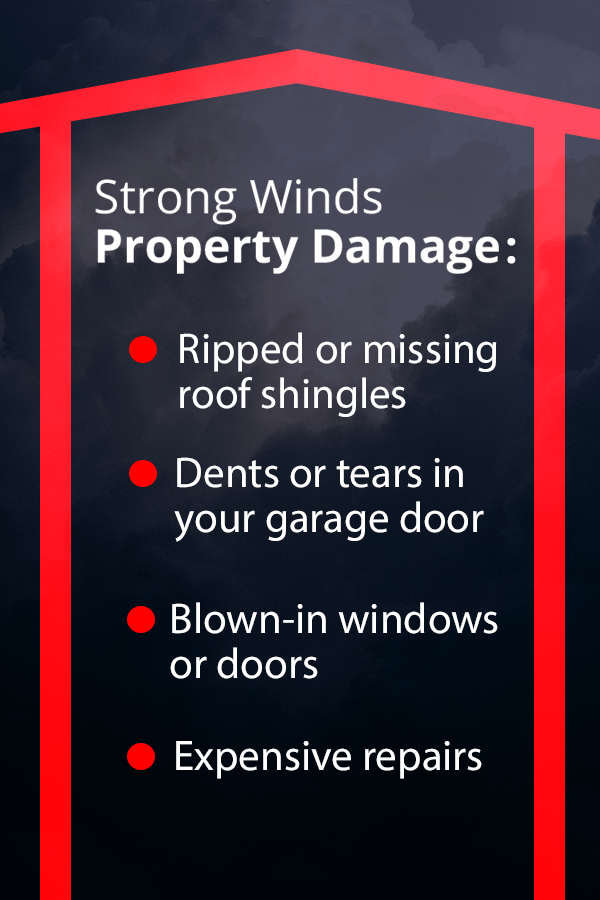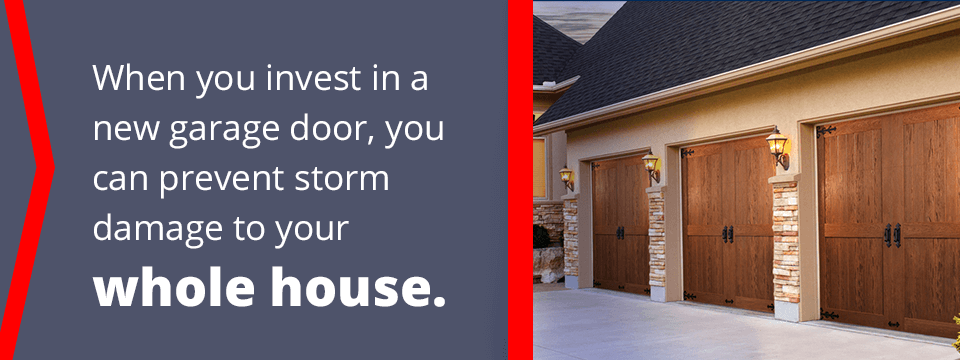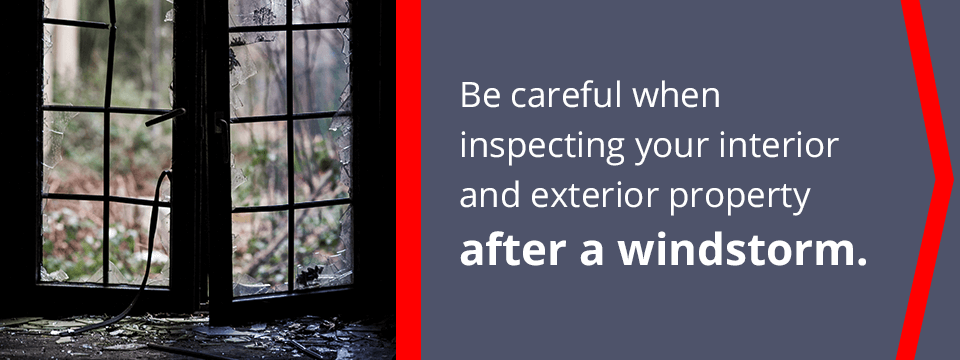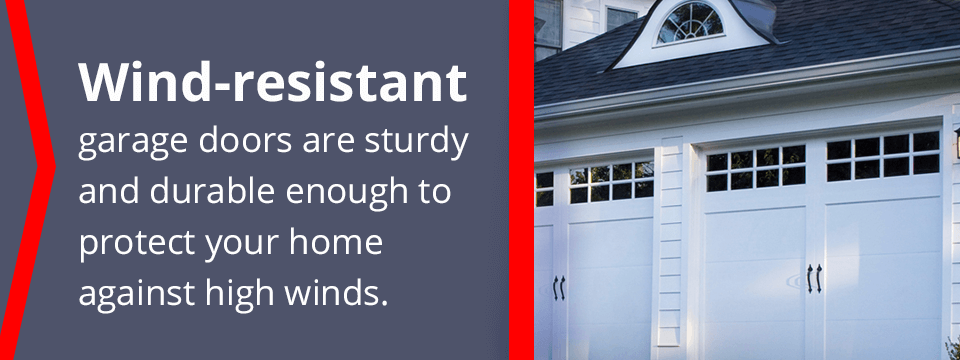How to Protect Your Home From High Winds

Residents of Southern Florida may experience hurricanes many times during the year. Most homes in this area feature structural designs that comply with local wind-rated codes. However, every part of your property must be able to withstand harsh storms, including high winds. It’s vital to know how to prevent wind damage to avoid costly repairs and devastation to your living space.
Investing in a sturdy, impact-rated garage door can guard your home against heavy gusts and windborne debris. Explore how to protect your house from high winds.
Table of Contents:
- The Consequences of Failing to Prepare Your Home
- How to Protect Your House from High Winds
- How to Restore Your Home from Wind Damage
- The Benefits of Impact-Rated Garage Doors
The Consequences of Failing to Prepare Your Home for High Winds
The following types of damage can occur to your property as a result of strong winds:
- Ripped or missing roof shingles: After a windstorm, you may notice missing or ripped shingles from your roof. The gaps on the top of your house can allow rainwater inside and cause stains, mold or mildew to develop. Even if the shingles look like they’ve remained intact, the nails holding them in place may have loosened. The adhesive under them could’ve also weakened. To prevent this damage to your home, consider how to protect your roof from high winds.
- Dents or tears in your garage door: Besides protecting your roof, you’ll also need to know how to protect your garage door from wind damage. A garage door is large compared to other openings in the home, so it’s more vulnerable to high winds. Gusts can tear and bend an unreinforced door away from the house during a severe storm. When this damage happens, your interior property will be vulnerable to flooding and impact from debris.
- Blown-in windows or doors: The garage door is a gateway into the rest of your home. When a storm brings heavy winds onto your property, it can create uncontrolled internal pressure. As a result, your walls, windows and doors could break or bend, causing severe structural damage to your home.
- Expensive repairs: When high winds and heavy debris tear through or break your property, you’ll need to get the affected building components replaced. Repairs can cost a considerable amount of money and take much time to complete. Investing in new, wind-rated parts for your home will save you the time and money that you would’ve spent replacing the damage from a storm.
How to Protect Your House From High Winds
These tips will help you protect your home from strong winds.
How to Protect the Inside of Your House
While you’re inside, you can follow these tips for keeping your home safe during a windstorm:
- Review your insurance policy: Homeowners’ insurance usually covers storm damage to your property. Before the next hurricane, examine your specific policy to know what it covers. When you take the time to familiarize yourself with your plan, you can conveniently submit a claim to get your home restored more quickly.
- Note all your belongings: Documenting all the items in your home can help you file your insurance claim after a storm. Take pictures of your expensive valuables or record a video while walking through your home to keep account of your possessions.
- Relocate your valuables: It helps to put your jewelry and important documents in a safe location in case of intruders or flooding. Since the first floor is the most vulnerable to floodwater, consider relocating your items upstairs or in the attic if possible.
- Designate a safe room: Homes in Southern Florida can usually withstand the local area’s severe winds. However, it also helps to create a safe space in the house where you can seek shelter during a storm. The room should also be away from glass items, especially doors and windows.
- Use protective window treatments: To protect windows from winds, set up storm shutters and keep them closed during a storm. These components prevent windows from breaking from windborne debris or heavy wind pressure. If you’re concerned about the glass throughout your home’s exterior breaking, you may also want to add shatter-resistant film or stormproof high-impact glass.
- Seal garage doors and double-entry doors: Flimsy garage and entry doors can break or blow in due to wind pressure. Reinforce your garage door with girts and lubricate the moving parts to strengthen the wheels on the tracks. You can also enhance the protection of your double-entry doors with heavy-duty deadbolt or slide bolts. Secure your doors with longer hinge attachments on the frame.
- Replace your windows and doors: One of the most efficient methods for protecting windows from strong winds is to get new ones. Investing in impact-resistant windows and doors will save you money in replacement parts after a storm. These products can withstand the pressure from heavy gusts to keep your property safe.
- Follow updates from the weather channel: Local weather reports may help you prepare your home for a severe windstorm. If you suspect a hurricane is coming, watch or listen to the weather channel to stay updated on vital information. They can inform you about evacuation orders and where to find shelter in your area. If you have to evacuate, do so as soon as possible.
- Unplug all electronic items: An unexpected power surge may damage the circuit board. If you lose power during the storm, unplug all the appliances and items in your electrical sockets. Avoid plugging them back in until the storm is over and your home has regained power. You may also want to use surge protectors to keep the circuits intact in case of a power surge.
How to Protect the Outside of Your House
Here are some ways you can protect your home’s exterior:
- Trim or remove dead branches or trees: High winds can rip off weak limbs and knock down dead trees. The impact from these heavy objects can tear your walls and affect your home’s structural integrity. Before your next storm, trim or remove your damaged trees, especially if they are closer than 40 feet to your house.
- Get rid of waste and debris in your yard: Any lightweight objects outside the home could fly into the air and damage your siding, windows and doors. Leaves can also build up on your roof and cause mold to develop. Walk around your yard and throw out any trash or debris you find on the ground.
- Secure furniture and appliances outside of the home: Consider putting your portable garbage cans, sports equipment and furniture in your shed or garage so they don’t fly in the wind. It also helps to ensure that your HVAC system and other outdoor appliances are secure on the ground.
- Seal gaps and cracks: During a hurricane, water and air leaks can enter your home and cause interior damage. Caulk around the windows and doors of your home to seal any gaps or openings around them.
- Replace gravel and rock landscaping materials: Heavy winds can pick up the rock and gravel and dent your home’s exterior. Instead of using these materials for your landscaping, try replacing them with mulch or dirt.
- Maintain your garage door: Your garage door is a significant opening into your home. If any of its components are broken or worn-out, the door can bring wind and debris into your living space. An annual tune-up from a local professional can help keep your property secure against heavy winds. During the maintenance appointment, the technician will lubricate all the metal components of your door and inspect the whole system for cracks and gaps.
- Repair or replace your garage door: While maintaining your garage door, the specialist may recommend which parts to update to prolong your product’s lifespan. They may also suggest upgrading to a wind-resistant garage door, especially if yours isn’t up to code. When you invest in a brand-new garage door, you can prevent costly damage to your whole house during a storm.
- Protect the top of your home: When you prevent wind damage to the roof, you’ll protect your entire property from wind damage and leaks. Inspect your roof’s shingles and underlayment for missing or torn components. Re-attach the loose shingles that may have fallen off the top of your home. Depending on where you live, you may even want to invest in clay tiles instead of asphalt shingles. A reliable roofing contractor should install your roof correctly so it can stay sturdy during the next storm.
What to Do If You Experience Wind Damage
When your property suffers from wind damage, follow these steps to restore your home:
- Practice safety precautions: Be careful when inspecting your interior and exterior property after a windstorm. While you walk through your yard and living space, watch out for any hazardous materials, such as broken glass or exposed nails. Avoid going near downed power lines in the street, and shut off the main gas line if you smell gas somewhere in the house.
- Document the aftermath of the storm: When you file your insurance claim, you must provide evidence of any storm damage to your home. As soon as it’s safe to go outside, walk around your whole property and take pictures of any dents, cracks or missing components. Note any wind damage to the roof and inform your homeowners insurance provider promptly.
- Test your garage door: After a storm, it’s vital to check your garage door so you can keep your property safe from intruders. Try opening and closing your garage door automatically and check the panels, openers and locks for cracks or missing pieces. If there are any water leaks, structural damage or operation problems, call a professional garage door specialist immediately.
- Call your insurance agent: When you inform your insurance provider of the storm damage, an adjuster will visit your home to assess the projected repair costs. Most insurance companies cover replacing broken garage doors and other building components, but you should confirm your policy’s coverage.
- Look for a reliable professional to repair your home: While you’re waiting for your insurance reimbursement, you might have to make temporary repairs to cover gaps and cracks. If you suspect that the shingles lifted, call a professional roofing contractor to repair the damage. Get a few estimates before choosing the right company to fix your roof. You can also contact your local garage door company to update this component of your property. Check with your insurance provider before hiring any contractor to confirm that they’ll reimburse you.
The Benefits of Impact-Rated Garage Doors
Wind-resistant garage doors are sturdy and durable enough to protect your home against high winds. They comply with local building codes, and their high-quality materials can withstand wind pressure and windborne debris. Consider some of the reasons you should upgrade to an impact-rated garage door:
- Protection against heavy winds: An impact-rated garage door includes thick, galvanized steel and a twist-resistant framework. These components keep the door from bending and breaking from the forceful winds outside your property, providing the appropriate wind protection for the home.
- Resistance to impact damage: Standard garage doors tend to dent or scratch when debris knocks into them during a storm. On the other hand, impact-resistant garage doors resistant have a steel coating around them to protect them from windborne objects.
- Security against intruders: Besides protecting your house against heavy winds, an impact-rated garage door can also keep out invaders. After a heavy storm, people may wander around the neighborhood, looking for vulnerable, damaged homes. If you have an attached garage, a broken door provides convenient access to the rest of your house. However, with robust and impenetrable steel on your door, your property is more likely to be safe from theft and vandalism.
- Durability and long lifespan: Impact-rated garage doors feature steel and wood composite panels. These sturdy, long-lasting materials can withstand most types of damage to protect your property for decades. Look for products with WindCode® reinforcement, a protective element that satisfies building codes. Since your door will be free from dents and scrapes, it’ll also enhance your home’s curb appeal.
- Aesthetically pleasing decorative elements: A modern wind-resistant garage door features more than a boring industrial steel panel. You can find wind-rated garage doors in various unique styles to complement your home’s design aesthetic. You can also get a galvanized-steel door with a wood composite overlay for a carriage-house appearance.
- Long-term financial gain: An impact-rated garage door protects your property against permanent damage. As a result of your upfront investment, you can avoid having to put money toward future repairs.
- Few maintenance requirements: Since a hurricane-rated garage door has long-lasting materials, it doesn’t need as much care as other products. An annual tune-up is still necessary, but until your next appointment, you’ll have peace of mind that your garage door will last against harsh storms without the need for additional reinforcement.
The Doorman Can Help You Prepare Your Garage for High Winds
Knowing how to protect your garage door from high winds will keep your whole property safe during the next storm. Our team at The Doorman of Southeast Florida provides WindCode®-rated residential garage doors to meet the local regulations and standards for hurricane resistance. We also have impact-rated entry and patio doors in our inventory for additional wind protection for the home. If you need to upgrade any of your doors to prepare for the next hurricane, reach out to us online or call us at 561-600-9606.




